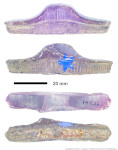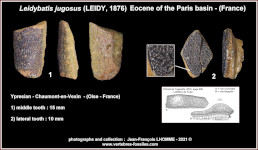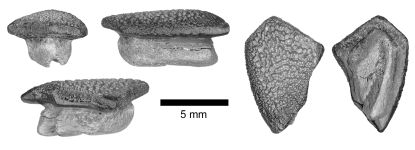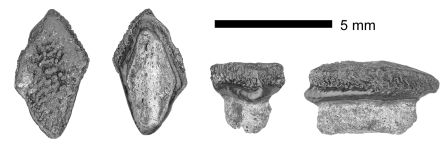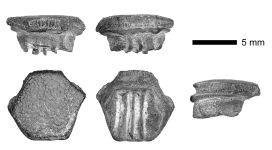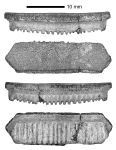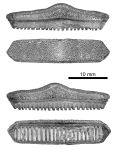Leidybatis jugosus
(Leidy, 1876)
Classification: Elasmobranchii Myliobatiformes Myliobatidae
Reference of the original description
Remarks on fossils of the Ashley phosphate beds. Proceedings of the Academy of Natural Sciences of Philadelphia, 28, 86–87
Remarks on fossils of the Ashley phosphate beds. Proceedings of the Academy of Natural Sciences of Philadelphia, 28, 86–87
Image of the original description
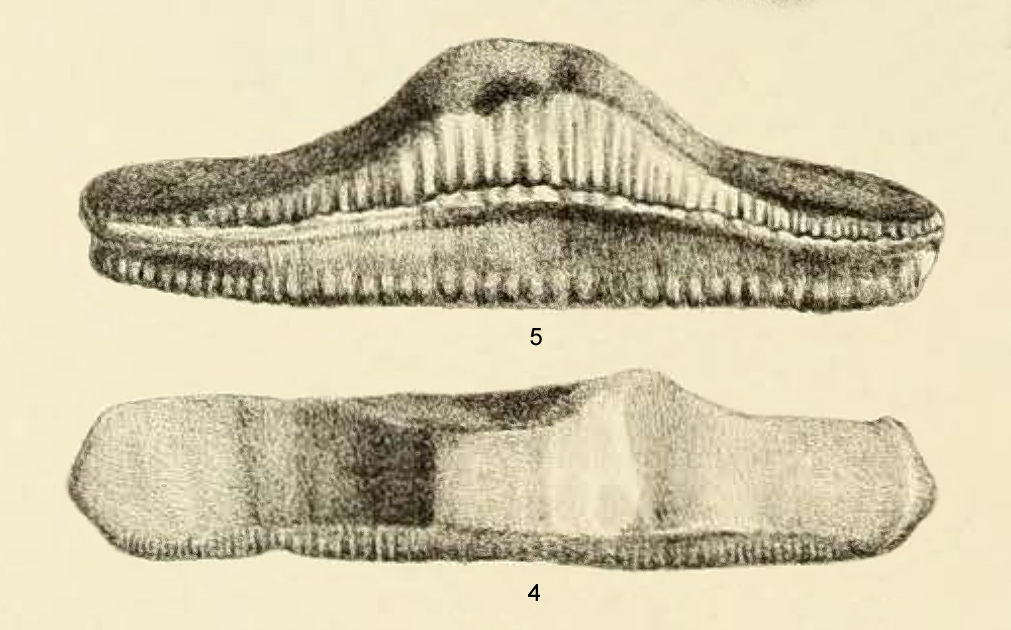
Leidybatis jugosus (Leidy, 1876); image of the first description (pl. 31 figs 4-5), holotype, ?Manasquan Marls, Manasquan Formation, latest Paleocene to late Ypresian; Vincentown, New Jersey, USA; coll. Academy of Natural Sciences of Philadelphia, P 14536

Leidybatis jugosus (Leidy, 1876); image of the first description (pl. 31 figs 4-5), holotype, ?Manasquan Marls, Manasquan Formation, latest Paleocene to late Ypresian; Vincentown, New Jersey, USA; coll. Academy of Natural Sciences of Philadelphia, P 14536
Synonyms / new combinations and misspellings
Leidybates jugosus, Leidybatis cf. jugosus, Leidybatus jugosus, Myliobates jugosus, Myliobatis cf. jugosus, Myliobatis jugosus, Rhinoptera jugosus
Leidybates jugosus, Leidybatis cf. jugosus, Leidybatus jugosus, Myliobates jugosus, Myliobatis cf. jugosus, Myliobatis jugosus, Rhinoptera jugosus
Description:
Citation: Leidybatis jugosus (Leidy, 1876): In: Database of fossil elasmobranch teeth www.shark-references.com, World Wide Web electronic publication, Version 01/2026
Please send your images of "Leidybatis jugosus" to info@shark-references.com
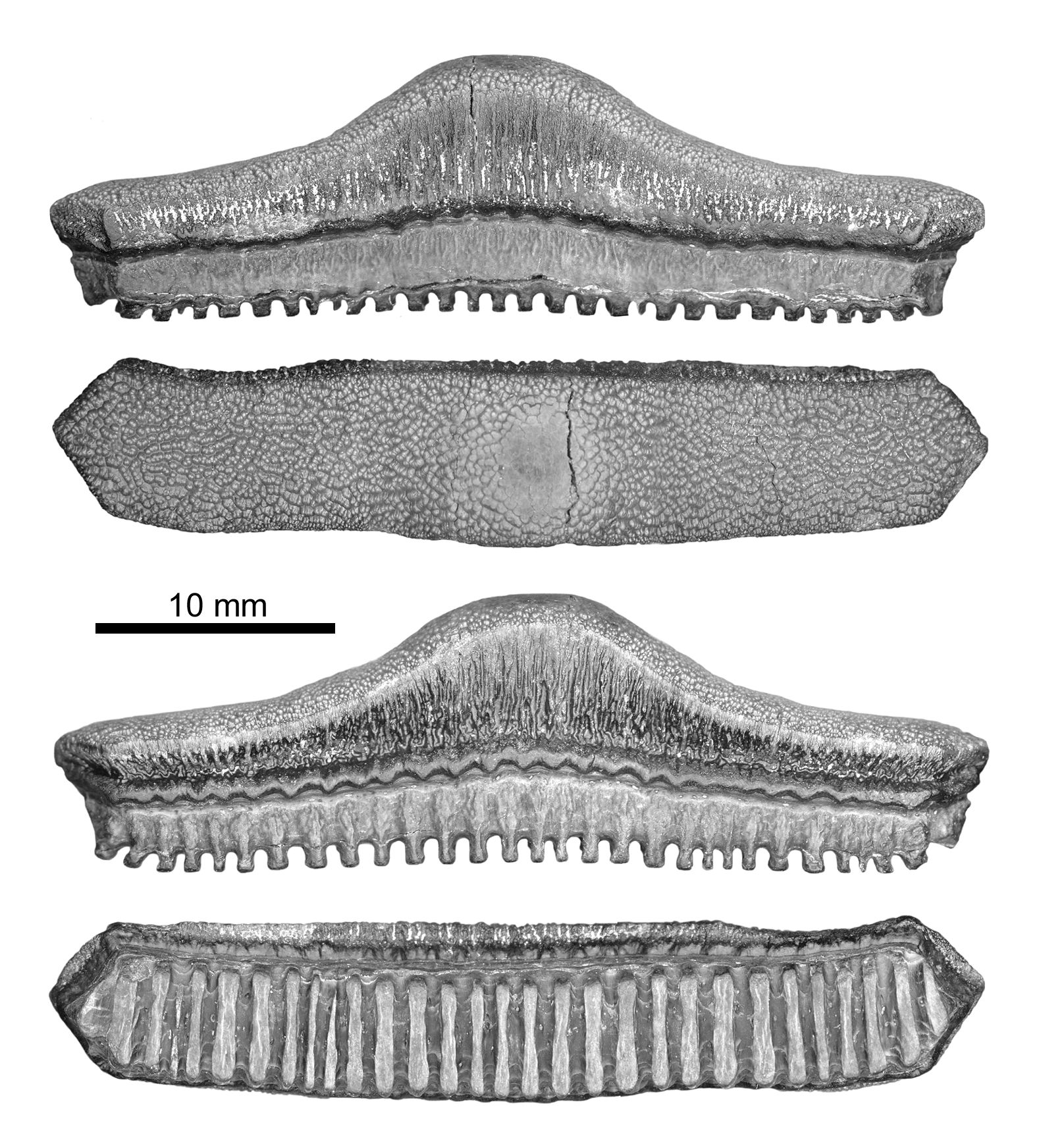
Leidybatis jugosus (Leidy, 1876); Egemkapel Clay Member, Bed IV, "Ditrupa Sand", Tielt Formation, Ypresian, Egemkapel, Belgium; Symphyseal tooth (morphotype 1), H=11.1, W=39.3 mm, L=8.1 mm; IRSNB P 10678; © T. Reinecke, Bochum

Leidybatis jugosus (Leidy, 1876); Egemkapel Clay Member, Bed IV, "Ditrupa Sand", Tielt Formation, Ypresian, Egemkapel, Belgium; Symphyseal tooth (morphotype 1), H=11.1, W=39.3 mm, L=8.1 mm; IRSNB P 10678; © T. Reinecke, Bochum
Description
Original description after Leidy (1876) [1419] (only name), description in Leidy (1877) [1420]:
An isolated median tooth, represented in figures 4, 5, Pl. XXXI, probably indicates a species of eagle ray different from the former. The specimen is likewise from the marl of Vincenttown, Burlington Co., N. J., and was recenly presented to the Academy by Col. T.M. Bryan.
The tooth is transversely nearly straight, and the ends are angular and adapted to the articulation of small hexagonal teeth as in the species of Myliobates generally. The crown forms a thick median transversely convex prominence with the sides extended outwardly and thin. The prominence appears as an exaggeration of the median ridge of the dental plate of M. fastigiatus due to the more abrupt depression of the sides of the crown. The tooth at the median prominence is no thicker than in the smaller of the dental plates described under the name of M. fastigiatus, while it is considerably broader. The triturating surface is transversely convex on the median prominence and becomes nearly flat upon its reflected sides. The dull aspect of the triturating surface, and the comparatively thin condition of the sides of the crown probably indicate some reduction as the result of wearing. The anterior inclining surface of the crown and the projecting posterior surface indicate a somewhat imbricated arrangement of the median teeth. In the specimen the back of the eminence of the crown is unsymmetrical, apparently deformed. The base of the crown opposite the median eminence is concave, and this curvature at the sides is slightly deflected. The root is straight on its attaching surface.
The breadth of the tooth is nearly 2 1/2 inches; its median height 8 ¾ inches, and at the sides 4 lines. The width of the crown fore and aft is about 5 lines, and its thickness at the middle about the same, while at the sides it is but 1 ½ lines.
Original description after Leidy (1876) [1419] (only name), description in Leidy (1877) [1420]:
An isolated median tooth, represented in figures 4, 5, Pl. XXXI, probably indicates a species of eagle ray different from the former. The specimen is likewise from the marl of Vincenttown, Burlington Co., N. J., and was recenly presented to the Academy by Col. T.M. Bryan.
The tooth is transversely nearly straight, and the ends are angular and adapted to the articulation of small hexagonal teeth as in the species of Myliobates generally. The crown forms a thick median transversely convex prominence with the sides extended outwardly and thin. The prominence appears as an exaggeration of the median ridge of the dental plate of M. fastigiatus due to the more abrupt depression of the sides of the crown. The tooth at the median prominence is no thicker than in the smaller of the dental plates described under the name of M. fastigiatus, while it is considerably broader. The triturating surface is transversely convex on the median prominence and becomes nearly flat upon its reflected sides. The dull aspect of the triturating surface, and the comparatively thin condition of the sides of the crown probably indicate some reduction as the result of wearing. The anterior inclining surface of the crown and the projecting posterior surface indicate a somewhat imbricated arrangement of the median teeth. In the specimen the back of the eminence of the crown is unsymmetrical, apparently deformed. The base of the crown opposite the median eminence is concave, and this curvature at the sides is slightly deflected. The root is straight on its attaching surface.
The breadth of the tooth is nearly 2 1/2 inches; its median height 8 ¾ inches, and at the sides 4 lines. The width of the crown fore and aft is about 5 lines, and its thickness at the middle about the same, while at the sides it is but 1 ½ lines.
Remarks
shark-references Species-ID=3466;
valid after Cappetta & Case (2016) p. 67 [24889]; Ebersole et al. (2019) p. 140 [27789];
shark-references Species-ID=3466;
valid after Cappetta & Case (2016) p. 67 [24889]; Ebersole et al. (2019) p. 140 [27789];
References

Biodiversity and paleoenvironments of vertebrate-rich Eocene marine deposits (Lutetian) of the tropical western Neotethys: New insights from the Arabian Platform. Journal of Asian Earth Sciences, 288, Article 106604
DOI: 10.1016/j.jseaes.2025.106604

Fossil chondrichthyans of the Carpathian-Pannonian Region (in Hungarian: A Kárpát-Pannon-térség fosszilis porcoshalai). Hungarian Natural History Museum, Dabasi Nyomda Zrt., Budapest. 255 pages, ISBN 978-963-9877-52-8

Batomorphs (Elasmobranchii: Rhinopristiformes, Rajiformes, Torpediniformes, Myliobatiformes) of the middle to late Ypresian, early Eocene, in the Anglo-Belgian Basin (south-western North Sea Basin) – a review and description of new taxa. Palaeontos, 35, 1–172
Reassessment of historical sections from the Paleogene marine margin of the Congo Basin reveals an almost complete absence of Danian deposits. Geoscience Frontiers, 10(3), 1039-1063
DOI: 10.1016/j.gsf.2018.06.002
A new Odontorhytis species (Chondrichthyes) from the Middle Eocene of Elgedida Mine, Bahariya Oasis, Egypt. Egyptian Journal of Geology, 63, 407–415
Taxonomy and biostratigraphy of the elasmobranchs and bony fishes (Chondrichthyes and Osteichthyes) of the lower-to-middle Eocene (Ypresian to Bartonian) Claiborne Group in Alabama, USA, including an analysis of otoliths. European Journal of Taxonomy, 585, 1–274
DOI: 10.5852/ejt.2019.585

A Selachian Fauna from the Middle Eocene (Lutetian, Lisbon Formation) of Andalusia, Covington County, Alabama, USA. Palaeontographica, Abt. A, 307(1–6), 43–103

Chondrichthyan tooth enameloid: past, present, and future. Zoological Journal of the Linnean Society, 174(3), 549–570
DOI: 10.1111/zoj.12244

Some new Eocene elasmobranch reports from the Outer Western Carpathians (Moravia, Czech Republic). Neues Jahrbuch für Geologie und Paläontologie, Abhandlungen, 268(1), 113–123
DOI: 10.1127/0077-7749/2013/0322


Generic Assessment and Reallocation of Cenozoic Myliobatinae based on new information of tooth, tooth plate and caudal spine morphology of extant taxa. Palaeontos, 24, 1–66

An inquiry into the stratigraphic occurrence of a Claibornian (Eocene) vertebrate fauna from Covington County, Alabama. Bulletin of the Alabama Museum of Natural History, 31(2), 60–73
Eocene (Lutetian) Shark-Rich Coastal Paleoenvironments of the Southern North Sea Basin in Europe: Biodiversity of the Marine Fürstenau Formation Including Early White and Megatooth Sharks. International Journal of Oceanography, 2012, Article ID 565326
DOI: 10.1155/2012/565326

The Elasmobranch Fauna of the Lede Sand Formation at Oosterzele (Lutetian, Middle Eocene of Belgium). Palaeofocus, 1, 1–57

A remarkable Eocene ichthyofauna from the El Gedida glauconitic sandstone, Bahariya oasis, Egypt, and its stratigraphic implications. M.E.R.C. Aïn Shams University, Earth Science Series, 21: 81–98, 4 fig., pl. 1–3.

Angaben zur Hai- und Rochenfauna aus dem Eozän von Turnu Roșu (Rumänien). Naturwissenschaftliche Forschung über Siebenburgen VI. Beitrage zur Geographie, Botanik, Zoologie und Palaontologie. Siebenburgisches Archiv, 36, 265–270

Colecţia de selacieni - Richard Breckner [Richard Breckner selachian collection]. Studii şi comunicări, Științele Naturii, Muzeul Brukenthal, 28: 115–119

Leidybatis jugosus Leidy 1877 - a new species for Romania. Naturalia, Studii şi cercetări, Pitești, 2/3, 73–76

De visfauna uit de basis van de Klei van Egemkapel in de groeve Ampe te Egem (onder eoceen van Noordwest -Belgie) Tielt, 1994

Soortenlijst van fossiele vissen uit het Eoceen van België. Afzettingen WTKG, 15(4), 6–12

Les chondrichthiens elasmobranches del la Tuilerie de Gan (Pyrénées Atlantiques, France). Cossmanniana, 1(2–4), 15–26

A checklist of Neoselachii (Pisces, Chondrichthyes) from the Palaeogene of the Paris Basin, France. Tertiary Research, 13(1) , 27–36

Die Neoselachier der Paleokaribik (Pisces: Elasmobranchii). Courier Forschungsinstitut Senckenberg, 119, 1–102

Une riche faune de sélaciens dans le bassin à phosphate de Kpogamé-Hahotoé (Éocène moyen du Togo): Note préliminaire et précisions sur la structure et l'âge du gisement. Geobios, 21(3), 359–365
DOI: 10.1016/S0016-6995(88)80058-5

Stand der Untersuchungen an der Chondrichthyes-Fauna des nordwestdeutschen Tertiärs. Beiträge zur regionalen Geologie der Erde, 18, 503–509

Paleogene sea snakes and elasmobranch fishes of South Kazakhstan. Paleontologitchesky Sbornik, 21, 69–74

Eine Lagerstätte kreidezeitlicher und paläogener Chondrichthyes-Reste bei Fürstenau (Niedersachsen). Osnabrücker Naturwissenschaftliche Mitteilungen, 6, 35–44

Les poissons fossiles du Bas-Congo et des régions voisines. Annales du Musée du Congo Belge, Sér. A (Minéralogie Géologie, Paléontologie), 3, 2(3): 257–568

Les faunes ichthyologiques du Crétacé et du Cénozoïque de l'Angola et de l'Enclave de Cabinda. Leurs affinités paléobiogéographiques. Comunicações dos Serviços Geológicos de Portugal, 38(2), 269–290

Check list of the fossil fishes of New Jersey. Journal of Paleontology, 20(5), 510–513

Contribution à l'étude des faunes ichthyologiques marines des terrains tertiaires de la Plaine Côtière Atlantique et du centre des Etats-Unis. Les synchronismes des formations tertiaires des deux côtés de l'Atlantique. Mémoires de la Société géologique de France, 45(2–4), 1–110
A description of the fossil fish remains of the Cretaceous, Eocene and Miocene formations of New-Jersey. Geological Survey of New Jersey Bulletin, 4: 182 p., 108 fig.
Contribution à lètude des poisons fossils du Nord de la France et des regions voisines. Mémoires de la Société géologique du Nord, 5, 1–430
Les poissons éocènes de la Belgique. Mémoires du Musée Royal d'Histoire Naturelle de Belgique, 3(11), 49–228

Bibliography and catalogue of the fossil Vertebrata of North America. Bulletin of the United States Geological and Geographical Survey of the Territories, 179, 1–868

Description of vertebrate remains, chiefly from the Phosphate Beds of South Carolina. Journal of the Academy of Natural Sciences of Philadelphia, 8(2), 209–261

Biodiversity and paleoenvironments of vertebrate-rich Eocene marine deposits (Lutetian) of the tropical western Neotethys: New insights from the Arabian Platform. Journal of Asian Earth Sciences, 288, Article 106604
DOI: 10.1016/j.jseaes.2025.106604

Fossil chondrichthyans of the Carpathian-Pannonian Region (in Hungarian: A Kárpát-Pannon-térség fosszilis porcoshalai). Hungarian Natural History Museum, Dabasi Nyomda Zrt., Budapest. 255 pages, ISBN 978-963-9877-52-8

Batomorphs (Elasmobranchii: Rhinopristiformes, Rajiformes, Torpediniformes, Myliobatiformes) of the middle to late Ypresian, early Eocene, in the Anglo-Belgian Basin (south-western North Sea Basin) – a review and description of new taxa. Palaeontos, 35, 1–172
Reassessment of historical sections from the Paleogene marine margin of the Congo Basin reveals an almost complete absence of Danian deposits. Geoscience Frontiers, 10(3), 1039-1063
DOI: 10.1016/j.gsf.2018.06.002
A new Odontorhytis species (Chondrichthyes) from the Middle Eocene of Elgedida Mine, Bahariya Oasis, Egypt. Egyptian Journal of Geology, 63, 407–415
Taxonomy and biostratigraphy of the elasmobranchs and bony fishes (Chondrichthyes and Osteichthyes) of the lower-to-middle Eocene (Ypresian to Bartonian) Claiborne Group in Alabama, USA, including an analysis of otoliths. European Journal of Taxonomy, 585, 1–274
DOI: 10.5852/ejt.2019.585

A Selachian Fauna from the Middle Eocene (Lutetian, Lisbon Formation) of Andalusia, Covington County, Alabama, USA. Palaeontographica, Abt. A, 307(1–6), 43–103

Chondrichthyan tooth enameloid: past, present, and future. Zoological Journal of the Linnean Society, 174(3), 549–570
DOI: 10.1111/zoj.12244

Some new Eocene elasmobranch reports from the Outer Western Carpathians (Moravia, Czech Republic). Neues Jahrbuch für Geologie und Paläontologie, Abhandlungen, 268(1), 113–123
DOI: 10.1127/0077-7749/2013/0322


Generic Assessment and Reallocation of Cenozoic Myliobatinae based on new information of tooth, tooth plate and caudal spine morphology of extant taxa. Palaeontos, 24, 1–66

An inquiry into the stratigraphic occurrence of a Claibornian (Eocene) vertebrate fauna from Covington County, Alabama. Bulletin of the Alabama Museum of Natural History, 31(2), 60–73
Eocene (Lutetian) Shark-Rich Coastal Paleoenvironments of the Southern North Sea Basin in Europe: Biodiversity of the Marine Fürstenau Formation Including Early White and Megatooth Sharks. International Journal of Oceanography, 2012, Article ID 565326
DOI: 10.1155/2012/565326

The Elasmobranch Fauna of the Lede Sand Formation at Oosterzele (Lutetian, Middle Eocene of Belgium). Palaeofocus, 1, 1–57

A remarkable Eocene ichthyofauna from the El Gedida glauconitic sandstone, Bahariya oasis, Egypt, and its stratigraphic implications. M.E.R.C. Aïn Shams University, Earth Science Series, 21: 81–98, 4 fig., pl. 1–3.

Angaben zur Hai- und Rochenfauna aus dem Eozän von Turnu Roșu (Rumänien). Naturwissenschaftliche Forschung über Siebenburgen VI. Beitrage zur Geographie, Botanik, Zoologie und Palaontologie. Siebenburgisches Archiv, 36, 265–270

Colecţia de selacieni - Richard Breckner [Richard Breckner selachian collection]. Studii şi comunicări, Științele Naturii, Muzeul Brukenthal, 28: 115–119

Leidybatis jugosus Leidy 1877 - a new species for Romania. Naturalia, Studii şi cercetări, Pitești, 2/3, 73–76

De visfauna uit de basis van de Klei van Egemkapel in de groeve Ampe te Egem (onder eoceen van Noordwest -Belgie) Tielt, 1994

Soortenlijst van fossiele vissen uit het Eoceen van België. Afzettingen WTKG, 15(4), 6–12

Les chondrichthiens elasmobranches del la Tuilerie de Gan (Pyrénées Atlantiques, France). Cossmanniana, 1(2–4), 15–26

A checklist of Neoselachii (Pisces, Chondrichthyes) from the Palaeogene of the Paris Basin, France. Tertiary Research, 13(1) , 27–36

Die Neoselachier der Paleokaribik (Pisces: Elasmobranchii). Courier Forschungsinstitut Senckenberg, 119, 1–102

Une riche faune de sélaciens dans le bassin à phosphate de Kpogamé-Hahotoé (Éocène moyen du Togo): Note préliminaire et précisions sur la structure et l'âge du gisement. Geobios, 21(3), 359–365
DOI: 10.1016/S0016-6995(88)80058-5

Stand der Untersuchungen an der Chondrichthyes-Fauna des nordwestdeutschen Tertiärs. Beiträge zur regionalen Geologie der Erde, 18, 503–509

Paleogene sea snakes and elasmobranch fishes of South Kazakhstan. Paleontologitchesky Sbornik, 21, 69–74

Eine Lagerstätte kreidezeitlicher und paläogener Chondrichthyes-Reste bei Fürstenau (Niedersachsen). Osnabrücker Naturwissenschaftliche Mitteilungen, 6, 35–44

Les poissons fossiles du Bas-Congo et des régions voisines. Annales du Musée du Congo Belge, Sér. A (Minéralogie Géologie, Paléontologie), 3, 2(3): 257–568

Les faunes ichthyologiques du Crétacé et du Cénozoïque de l'Angola et de l'Enclave de Cabinda. Leurs affinités paléobiogéographiques. Comunicações dos Serviços Geológicos de Portugal, 38(2), 269–290

Check list of the fossil fishes of New Jersey. Journal of Paleontology, 20(5), 510–513

Contribution à l'étude des faunes ichthyologiques marines des terrains tertiaires de la Plaine Côtière Atlantique et du centre des Etats-Unis. Les synchronismes des formations tertiaires des deux côtés de l'Atlantique. Mémoires de la Société géologique de France, 45(2–4), 1–110
A description of the fossil fish remains of the Cretaceous, Eocene and Miocene formations of New-Jersey. Geological Survey of New Jersey Bulletin, 4: 182 p., 108 fig.
Contribution à lètude des poisons fossils du Nord de la France et des regions voisines. Mémoires de la Société géologique du Nord, 5, 1–430
Les poissons éocènes de la Belgique. Mémoires du Musée Royal d'Histoire Naturelle de Belgique, 3(11), 49–228

Bibliography and catalogue of the fossil Vertebrata of North America. Bulletin of the United States Geological and Geographical Survey of the Territories, 179, 1–868

Description of vertebrate remains, chiefly from the Phosphate Beds of South Carolina. Journal of the Academy of Natural Sciences of Philadelphia, 8(2), 209–261








